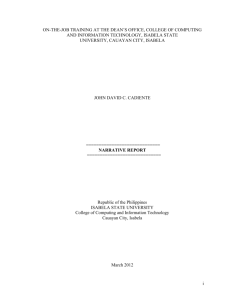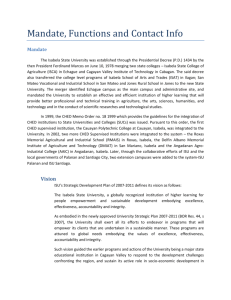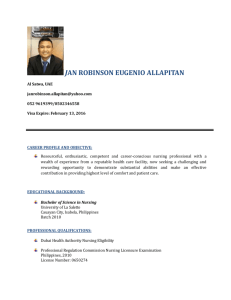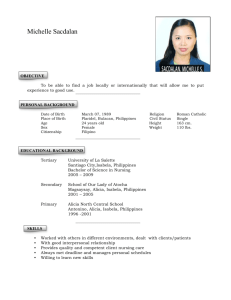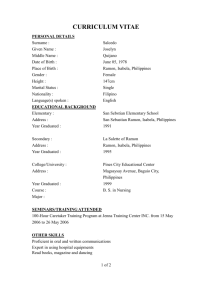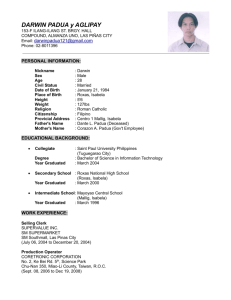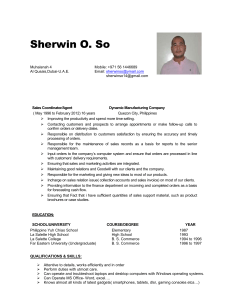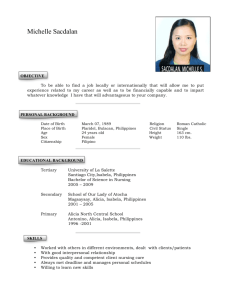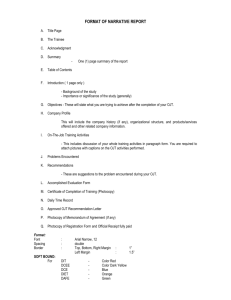BSIT On-the-Job Training Narrative Report
advertisement
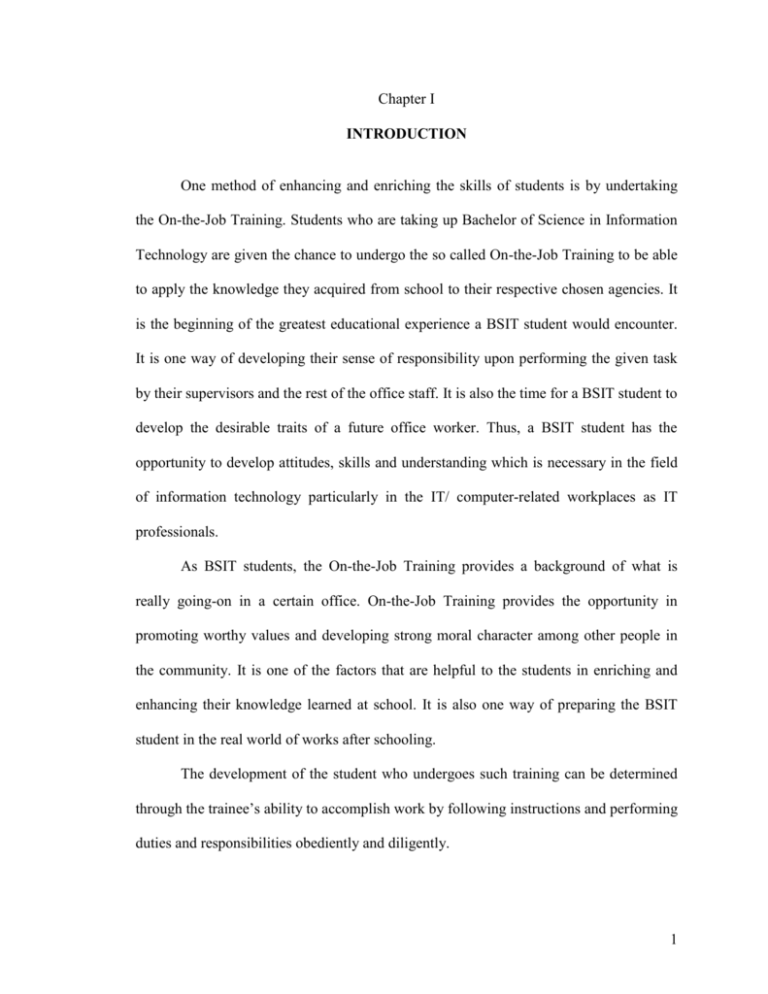
Chapter I INTRODUCTION One method of enhancing and enriching the skills of students is by undertaking the On-the-Job Training. Students who are taking up Bachelor of Science in Information Technology are given the chance to undergo the so called On-the-Job Training to be able to apply the knowledge they acquired from school to their respective chosen agencies. It is the beginning of the greatest educational experience a BSIT student would encounter. It is one way of developing their sense of responsibility upon performing the given task by their supervisors and the rest of the office staff. It is also the time for a BSIT student to develop the desirable traits of a future office worker. Thus, a BSIT student has the opportunity to develop attitudes, skills and understanding which is necessary in the field of information technology particularly in the IT/ computer-related workplaces as IT professionals. As BSIT students, the On-the-Job Training provides a background of what is really going-on in a certain office. On-the-Job Training provides the opportunity in promoting worthy values and developing strong moral character among other people in the community. It is one of the factors that are helpful to the students in enriching and enhancing their knowledge learned at school. It is also one way of preparing the BSIT student in the real world of works after schooling. The development of the student who undergoes such training can be determined through the trainee’s ability to accomplish work by following instructions and performing duties and responsibilities obediently and diligently. 1 The-On-The-Job-Training was conducted at the Dean’s Office, College of Computing and Information Technology, Isabela State University, Cauayan City, Isabela, from November 14, 2011 to January 26, 2012 for a total of three hundred twenty four (324) hours. A. Importance of the Practicum/ Job Training 1. It is tool in applying, enriching, and enhancing the acquired knowledge in the school. 2. It is a way of changing student’s outlook in life through exposure in the actual work that may serve as a stepping-stone towards the future life. 3. It develops inter personal relationship with other employees within the agency/Office. B. Objectives of the Practicum/ Job Training 1. To let the student realize and experience the actual world of work - a chance to enhance and develop their skills in the computerized environment. 2. To expose the students to the current trends and development in the particular agency or office. 3. To broaden the student’s practical experiences and their outlook to their line of work to have proper prospective and attitudes. C. Time and Place of the Practicum The On-The-Job Training was performed from Mondays to Fridays. This training was undertaken from November 14, 2011 to January 26, 2012 covering the required 324 hours at the Dean’s Office, College of Computing and Information 2 Technology, Isabela State University, Cauayan City, Isabela. The Office is open from 7:00 am to 12:00 noon and from 1:00 to 5:00 pm. 3 Chapter II BODY OF THE PRACTICUM A. Corporate/ Agency Background 1. Nature of the Agency 2. Mission/ Vision/ Goal Statement 3. History/ Background of the Agency/ Office 3. Organizational Structure B. Work Experience 1. Accomplishments/ Activities Date Accomplishment 2. Problems Encountered 4 Chapter III SUMMARY, CONCLUSION AND RECOMMENDATION Summary and Conclusion As a graduating student who is taking up Bachelor of Science in Information Technology, the course requires us to undergo the On-the-Job Training in order to experience the real world of works. And this activity will help us to enhance our skills and to succeed in our future workplace. Upon completing the number of hours needed for my On-the-Job Training, this is the summary and report of experiences and activity that I have undergone during my Onthe-Job Training at the Dean’s Office, College of Computing and Information Technology, Isabela State University – Cauayan Campus. This activity is one of the most unforgettable and remarkable periods in my life. It is the time when a student has to adjust himself/ herself to the nature of the agency where he/she belongs. During those days I am always busy, working in the office, dealing with my supervisor and office staffs as well as with different clients. On-the-Job Training was not really an easy task at all. Through this activity, I realized that working is not an easy job and that every person differs in so many ways. This activity helped me a lot in developing my personality as well as boosts my self-confidence in the workplace. It was a fruitful and enjoyable despite those hardships and problems I have encountered. It really enriched my knowledge and skills. It gave me also strength to face those trials that awaits me after graduation. This will serve as my stepping-stone to fulfill all my goals in my life. 5 As a conclusion, I am very thankful that I have already successfully finished my On-the-Job Training at the Student Dean’s Office, College of Computing and Information Technology, Isabela State University – Cauayan Campus. I really learned a lot from the activities performed that provides situation for development. I’m looking forward to apply all what I have learned in the actual performance in my future workplace. Recommendation 6 BIBLIOGRAPHY A. General References Articulo, Archimedes C. and Florendo, Gloria G., “Values and Work Ethics,” 2003. Reynolds, George, “Ethics in Information Technology,” 2006. Zulueta, Francisco M. and Greg Melthor C. Delare, “Human Behavior in Organization,” 2002. B. Narrative Report Jose, Kristel G., “Narrative Report of the On-The-Job Training, S.Y 2005-2006” (Isabela State University, Roxas Isabela). Dumalanta, Susana, “Narrative Report of the Internship Training S.Y.2003-2004 (Isabela State University, Roxas Isabela). 7 APPENDICES 8 Appendix A Republic of the Philippines ISABELA STATE UNIVERSITY Cauayan Campus City of Cauayan, Isabela GUIDELINES FOR ON-THE-JOB TRAINING AND NARRATIVE REPORT I. INTRODUCTION A. Mission, Vision and Goals of CCIT MISSION The Isabela State University is committed to train and develop students to become professionally competent graduates who are equipped with sound moral principles, and to serve the community through research, extension and resource generation by way of inspired leadership and responsive manpower. VISION The Isabela State University, a globally recognized institution of higher learning for people empowerment and sustainable development embodying excellence, effectiveness, accountability and integrity. GOALS The College of Computing and Information Technology provides students at equal opportunity to develop their computer skills based on the current relevant curricula. This scholastic preparation associated with different extracurricular activities and other related matters in research, extension and resource generation is necessary to build knowledge and experience to establish a powerful foundation in computer and information systems. Through this, the College shall produce 9 technologically – oriented, globally competent and effective IT graduates imbued with moral in their chosen profession. B. Objectives of the Practicum The objective of On-Job-training (OJT) is directly related to the teaching learning experiences and should help the student to: a. Enhance their knowledge and skills acquired in the classroom in order to become more responsive to the demands of Information Technology (IT) Profession. b. Develop the value of professionalism, love of work and commitment to people they serve. c. Feel and experience the actual world of work in computerized environment. d. Apply the relevant theory of IT professional Code of Ethics into practice. C. Importance of the Practicum 1. It is a tool for Applying, enriching and enhancing the acquired knowledge in the school in their particular field of endeavor. 2. It is the way of changing the student’s outlook in life through exposure in the performance of actual work that may serve as an stepping-stone for future life. 3. It develops interpersonal relationship with other employees within the placement agency/office. 10 D. Academic Qualifications 1. Students taking BSIT must have successfully defended his/her Thesis/Research Proposal (SAD 1) before he/she is allowed to enroll for OJT Training Course. If the student has an incomplete grade, he may be allowed to undergo said OJT and may complete deficiency provided the time spent for the purpose does not affect said OJT. 2. Student taking the Bachelor of Science in Information Technology with deficiency shall be allowed to undergo OJT provided those are minor subject and not major subjects. E. Selection of Agency/ Office In the selection of placement agency, the school takes into consideration the background, educational needs of the students, as well as the existing facilities of the agency/office through the recommendation of the OJT Coordinator assigned. The student may suggest or recommend such agency or office for the job training for their deployment and subject for approval by authorities concerned. The commitment and interest of the agency in participating in the preparation and molding competent IT professionals is being considered. This interest is reflected on the agency’s willingness to accommodate and facilitate the training of student’s practitioners in the world of computer. A letter of request is given to the agency asking for their support to the program. The letter stipulates their responsibilities of the agency and the 11 supervisor assigned to oversee the student’s activities. It also defines the activities that the agency should provide for the students. An endorsement letter is given to the trainee’s whom they should present to the head of the placement agency on the first day of their training. Likewise, the school shall enter into a Memorandum of Agreement (MOA) with the selected agency/office for the said purpose. F. Requirements The student are required to render/undergo 324-hours On-Job-Training (OJT) as required by the course All activities or task shall be reflected in the Time/Activity Management Plan Form to be accomplished daily by the student and to be reviewed and evaluate by the immediate supervisor assigned in the agency or office. The student trainee can take time-off for personal reasons with the approval of the supervisor or coordinator. Student are allowed to be absent during regular days and may observe holidays and be allowed to attend symposia or conferences, however, anytime lost must be made up or replaced. If the student trainee fails to render the required number of hours within the agreed span of time, he may be allowed extending until the time required is completed. All students will be treated as trainees not as regular employees. Hence, are not entitled for any salary, wages, allowances or any forms of remunerations. However, if the cooperating agency so desires, it may provide monetary or nonmonetary benefits on a voluntary basis. 12 On-Job-Training student are required to attend the orientation seminar and conference before they are endorsed to their respective agency/offices. Student –trainees are required to attend post –conference with their advisercoordinator on scheduled days to monitor the activities of the students and to give them opportunity to thresh out problems encountered in their respective office/agency assignment. The faculty adviser/coordinator shall conduct scheduled office visitations. The adviser confers with the supervisor concerning the activities and performance of the students during such visitations. G. Student Demeanor/ Behavior and Uniforms The student shall be guided by the university policies, rules and regulation and other pertinent policies, regulations and standard operating procedure of the cooperating agency or office. Students are expected to behave accordingly like professional during their training observing the Ten Commandments of Computer Ethics and Code of ethics of It professionals. Propriety in dress and deportment must be observed. Hence, they should be in their casual/business attire when they report to their respective offices during the entire training period. The student submits a parents’ letter/consent to the school allowing their son/daughter to undergo On-Job-Training. II. SUPERVISION To ensure that the objectives of the OJT program are realized, the students are supervise and monitor during the course of their training. 13 Supervision is done both by the faculty adviser/coordinator and the immediate supervisor in the placement agency. The adviser/coordinator aside from the scheduled conferences schedules office visitations. During such visitations, the adviser/coordinator confers with the supervisor concerning the activities and performance of the student (s) concerned. A. Responsibilities of the OJT Adviser/ Coordinator The role and responsibilities of the adviser/coordinator centers on his supervision and liaison functions between the school and the placement agency/office, especially; 1. Consult agencies on the placement of the students as On –The- Job Trainees. 2. Facilitates orientation seminar for student before their deployment/assignment to offices/agencies 3. Holds regular conferences with the students to discuss concerns and problems attendant to them. 4. Holds dialogue and consultation with the students when the needs arises. 5. Supervises and monitors the activities of the students pertinent to the OJT. 6. Keeps a record of the students, attendance during conferences. 7. Give the final evaluation or grade base on his/her performance from the placement agency/office, class presentation/oral report and written report. A. Responsibilities of the Student Practitioner/ Trainee 1. Manifest interest in all OJT activities as shown as in: 14 a. Attendance in conferences with the faculty adviser/coordinator. b. Attendance in punctuality in reporting to the placement agency. c. Willingness to accept responsibilities. d. Does work responsively, creatively and enthusiastically. C. Responsibilities of the Cooperating Agency/ Office 1. Shall provide assistance and guidance in the preparation of the activity/work plan. 2. Shall impart experiential learning and gives performances rating to the trainee(s).at the end of the period. 3. Shall require and monitor the daily attendance of the student(s). 4. Shall take the precautionary measures to safeguard the welfare of the students within the premises. III. EVALUATION The students are evaluated based on their Performance Rating from the agency/office, oral report and written report. It be submitted to the rating faculty adviser/coordinator after the 324-hours training services shall have been completed. Each student shall submit a typewritten report which shall serve or be used in oral reporting. Relevant information about the agency/office, diary of the daily activities, problems encountered and recommended solutions should be included in the report. The oral reporting should be presented for the 25 minutes to be followed by the short open forum with a maximum of 15 minutes. The topics for the presentation 15 included the activities encountered and their recommendations. The used of the chalk and board are allowed. After the oral reporting, the written report shall be returned to the student concerned for its finalization. The Proficiency Rating sheet is accomplished by the immediate supervisor of the student trainee where he/she is assigned A. Grading System Each student trainee shall be graded and evaluated based on the following criteria/area: Oral Report 20% Clarity Orderliness Use of Visual Aids Ability to answer inquiry Written Report 20% Quality of Content 60% Grammar Organization Quality of Format 40% Spacing Margins Headings Tables, Figures/Plate Typeset, Paging Performance Rating 60% Personal Qualities Job Performance 16 IV. FINAL REPORT AND FORMAT Seven (7) copies of a bound narrative report should be submitted duly signed by the authorized concerned. The original copy shall be submitted to the Registrar, while the remaining copies will be for the dean, Department chairman, Adviser, Library, Cooperating Agency/Office and the student trainee. All student trainees should work independently and submit hi/her own original work. Any student found submitting copied or duplicated reports will receive appropriate demerits and/or subject to disciplinary action (i.e., the student may lose credit in the written and consequently fail the subject). A. Cover The final copies of the narrative report shall be soft bound in maroon color with black lettering bearing necessary information as follows: Title (in inverted pyramid), name or kind of report, name of student(s), name of the university, and the year submitted (see sample). B. Page and Chapter Format Types of Headings. Centered heading of the major division of the report, and side heading and paragraph headings for subdivision shall be used. Aside from the headings and in the majority of case it should not be necessary to make additional subdivisions. Side Headings. The side headings should be aligned with the left margin of the narrative report. The first letter of each word is capitalized. Bold type face may be used to provide distinction from the rest of the manuscript, see the Page and Chapter Format side heading above. 17 Paragraph Headings. This subheading is underlined and not followed by a new paragraph, the text continuing of the same line as the heading. The entry should be indented about eight (8) spaces from the left margin. Only the first letter word is capitalized. Note that this paragraph has a typical Paragraph heading. Typeset, Line Spacing and Margin. The body of the narrative report shall be type in 12 characters per inch, double space. Tables and figures may be in either smaller typeset. Paragraph shall be indented for (8) spaces. However, the caption/titles for tables, figures and plates shall be in 12 cpi, The left margin shall be 1.5 inches, and 1 inch for all borders, Page Numbering. The page number of the preliminaries shall be numbered in small roman numerals (example i, ii, iii, and so on) with the title page considered as “i” but should not be typed. All other pages beginning with the first page of the report proper should be numbered in Arabic numerals. All pages number shall be located at the bottom center, and there should be at least (2) spaces (double space) before the last entry of the text in the page before the page number, and 1 inch from the page number to the bottom of the paper. C. Organization The following preliminaries shall be included in the first few pages of the report: a. Title Page (see sample) b. Approval Sheet 18 c. Acknowledgement d. Dedication e. Table of Contents f. Biographical Data of the Student g. List of Tables, Plates and Figures The report proper (oral reporting shall contain the following): a. Accomplished Training plan (please see sample plan) b. Relevant information about the agency or office assigned c. Diary of daily activities d. Recommendation/solution D. Tables, Figures and Plates Definitions. Data that will be presented as tabulated set of number shall be designated as tables, freehand or mechanical drawing/illustrations, graphs and sketches as figures, and color or black and white photograph as plates. As far as practicable, tables, plates and figures shall be integrated in the manuscript. Tables. Should be neatly designed and correctly or appropriately titled. The units used, the sample size and other reference symbols should be properly indicated. Asterisk should be reserved for indicating levels of significance. Arabic numbering of tables should be done in one continues sequence throughout the report. Single space typing should be used for tables. The inclusion of tables should be regulated so that only necessary ones are incorporated in the report. Other relevant tables may be included as appendix tables. 19 Figures. Figures should be drawn in Indian ink on white paper or card, or on thick tracing paper or plastic film. Photograph diagrams are also accepted. It is recommended that the width of a figure (diagram, graphs, histogram, etc.), drawn or printed on a separate sheet of paper of the same size at the side. In the case of line graphs, the zero (0) reference point shall always be included, unless the values for both X and Y axes are so large that a large space will occupy the graph, a break in the Y axis. However, the present trends of presenting graphs generated by computer software that automatically adjust the X and Y axes are acceptable. Plates. Photographs (plates) to be included in the report shall be off high quality, of appropriate size, and should be only those particularly relevant to the subject. Similar to figures, the plates should be fixes to a separate sheet of paper glue should be done carefully so that it will not spill over the opposite surface. Any form of tape (scotch, masking etc.) and photograph corners are not allowed. 20 Appendix B-1 Republic of the Philippines ISABELA STATE UNIVERSITY Cauayan Campus City of Cauayan, Isabela College of Computing and Information Technology November 11, 2011 DR. MARY JANE S. BITANGA Dean CCIT, ISU – Cauayan Campus San Fermin, Cauayan City, Isabela Sir/Madam: In partial fulfillment of the requirements for the Bachelor of Science in Information Technology program, the fourth year students of our institution are required to undertake 324 hours on-the-job training (OJT). In this regard, may I respectfully request you to be our industry partner and may I know if you could accommodate 1 of our students for the said purpose? Below are the list of skills and competencies of our students that your office may be able to enhance: 1. Computer Operations (e.g. Word Processing, Spreadsheet/Excel, Presentation Package/Powerpoint, E-mail & Internet Browsing). 2. Programming (e.g. Database Application, Application Development, Web Development) 3. Multimedia (Animation, Audio/Video Editing, Graphic Design) 4. Research (Project Development) 5. Networking (Cabling/Wiring, Data Communications) I look forward to your positive response. Thank you for your support! Very truly yours, DIONICIO D. GANTE OJT Coordinator 21 Appendix B-2 November 11, 2011 DIONICIO D. GANTE OJT Coordinator Isabela State University Cauayan City, Isabela Dear Sir/Madam: This is in response to your letter of inquiry regarding the possibility of accommodating your students for the On-the-Job Training in our agency/industry. _____ yes, we are very much willing to accommodate your students as specified in your letter. (If yes, please select the competencies you can offer the students) 1. Computer Operations (e.g. Word Processing, Spreadsheet/Excel, Presentation Package/PowerPoint, E-mail & Internet Browsing). 2. Programming (e.g. Database Application, Application Development, Web Development) 3. Multimedia (Animation, Audio/Video Editing, Graphic Design) 4. Research (Project Development) 5. Networking (Cabling/Wiring, Data Communications) _____yes, we can accommodate _____ students. _____ No, not this time. Thank you for considering our agency/industry as your partner in education and development. Very truly yours, DIONICIO D. GANTE Officer – in- Charge, Dean 22 Appendix B-3 Republic of the Philippines ISABELA STATE UNIVERSITY Cauayan Campus City of Cauayan, Isabela College of Computing and Information Technology November 11, 2011 Date TO WHOM IT MAY CONCERN: This is to certify that I am allowing my son, John David C. Cadiente to go on practicum (On-the-Job Training) for a total of four hundred eighty six (324) hours on November 14, 2011 until February 26, 2012 at Dean’s Office, College of Computing and Information Technology, ISU-CC in partial fulfillment of the requirements for the degree of Bachelor of Science in Information Technology. It is understood that he/she abides by the rules and regulations that may be imposed by the Supervisor/Staff-in-Charge for his/her welfare and safety. I fully agree to waive any responsibility on the part of the College of Computing and Information Technology of Isabela State University Cauayan Campus, College of Computing and Information Technology and/or the representative/s, in case of untoward incident that may happen to my son/daughter during the duration of the practicum. Lilia C. Cadiente Name of Parent/Guardian ________________________ Signature 11/11/2011 Date Student’s Name: John David C. Cadiente Home Address: New Airport Rd. San Fermin, Cauayan City Boarding House Address: None Student’s Contact Number/s: 09055569580 Parent/Guardian’s Contact Number/s: 09263118115 23 Appendix B-4 Republic of the Philippines ISABELA STATE UNIVERSITY Cauayan Campus City of Cauayan, Isabela College of Computing and Information Technology November 11, 2011 DR. MARY JANE S. BITANGA Dean CCIT, ISU – Cauayan Campus San Fermin, Cauayan City, Isabela Dear Madam: This refers to the requirement of the Bachelor of Science in Information Technology curriculum of the College of Computing and Information Technology at the Isabela State University Cauayan Campus for students to undergo an On-the-Job Training (OJT) for a total of three hundred twenty four (324) hours in any company with Information Technology base. In view of this, we would like to request that John David C. Cadiente to have his OJT in your company. In this manner, he will have opportunity to apply her theoretical knowledge in actual practice. We believe that your company can provide the relevant exposure to future Information Technology professionals, thus, ensuring the continuous supply of highly qualified personnel for Information Technology and Industry. We would highly appreciate whatever assistance you could extend to us that would, in the long run, be both beneficial to the student and your company. Thank you and we look forward to your kind consideration and support. Very truly yours, DIONICIO D. GANTE OJT Coordinator 24 Appendix B-5 November 11, 2011 Date TO WHOM IT MAY CONCERN: This is to inform you that John David C. Cadiente, On-the-Job Training (OJT) applicant is accepted to have his/her practicum on this company beginning November 14, 2011 until February 26, 2012. Name of Business: Dean’s Office, College of Computing and Information Technology, ISU-CC Business Address: San Fermin, Cauayan City, Isabela Contact Number/s: 652 – 35- 66 Certified true and correct, DR. MARY JANE S. BITANGA Signature over Printed Name DEAN___________ Position ______November 11, 2011_____ Date Signed 25 Appendix B-6 MEMORANDUM OF AGREEMENT This Memorandum of Agreement made and executed between: College of Computing and Information Technology of Isabela State University Cauayan Campus, a non-stock, non-profit educational institution, duly organized and existing under Philippine Laws with office/business address at National Highway, San Fermin, Cauayan City, Isabela represented herein by DIONICIO D. GANTE, Officerin-Charge, College of Computing and Information Technology hereinafter referred to as the UNIVERSITY. and College of Computing and Information Technology, a domestic corporation duly organized and existing under Philippine Laws with office/business address at San Fermin, Cauayan City, Isabela, represented herein by Dr. Mary Jane S. Bitanga, hereinafter referred to as the COMPANY. Witnesseth: The parties hereby bind themselves to undertake a Memorandum of Agreement for the purpose of supporting the UNIVERSITY’S On-the-Job Training (OJT) for Student-Trainees under the following terms and conditions: 1. The UNIVERSITY shall be responsible for briefing the On-the-Job StudentTrainees who intend to conduct practicum exposure in the COMPANY as part of the UNIVERSITY'S curriculum; 2. The UNIVERSITY shall provide the On-the-Job Student-Trainee the basic orientation on work values, behavior, and discipline to ensure smooth cooperation with the COMPANY; 3. The UNIVERSITY shall issue an official endorsement vouching for the well being of the On-the-Job Student-Trainee which shall be used by the COMPANY for processing the application of the Student-Trainee; 4. The UNIVERSITY shall voluntarily withdraw a Student-Trainee who is found to misbehave and/or act in defiance to existing standards, rules, and regulations of the COMPANY and impose necessary university sanctions to the said Student-Trainee; 5. The COMPANY may grant allowance and/or adequate insurance to StudentTrainee in accordance with the COMPANY'S existing rules and regulations; 6. The COMPANY, upon consultation with the UNIVERSITY, may require qualified students to submit themselves to examinations, interviews, and file pertinent documents to support their application; 7. The COMPANY is not obliged to employ Student-Trainee upon completion of the training; 8. The Student-Trainees shall be personally responsible for any and all liabilities arising from negligence in the performance of his/her duties and functions while under training; 26 9. There is no employer-employee relationship between the COMPANY and the Student-Trainee; 10. The duration of the program shall be equivalent to three hundred twenty four (324) working hours unless otherwise agreed upon by the COMPANY and the UNIVERSITY; 11. Any violation of the foregoing covenants will warrant the cancellation of the Memorandum of Agreement by the COMPANY within thirty (30) days upon notice to the UNIVERSITY. 12. This Memorandum of Agreement shall become effective upon signature of both parties and implementation will begin immediately and shall continue to be valid hereafter until written notice is given by either party thirty (30) days prior to the date of intended termination. In witness whereof the parties have signed this Memorandum of Agreement at ___________________________________ this _____ day of ___________________, 20___. For the COMPANY DR. MARY JANE S. BITANGA Dean, CCIT Community Tax No: Date of Issue: Place of Issue: For the UNIVERSITY DIONICIO D. GANTE Officer-in-Charge, CCIT Community Tax No: 278143 Date of Issue: March 14, 2011 Place of Issue: Sampaloc, Cabatuan, Isabela SIGNED IN THE PRESENCE OF: MS. ANGELA A. DINIEGA Representative of the Company EDDIE I. PERU IT Instructor ACKNOWLEDGEMENT Before me, a Notary Public in the province of Isabela, personally appeared _________________________ and _________________________ with Community Tax Certificates indicated above, known to me to be the same persons who executed the foregoing instrument and they acknowledged to me that the same is their free will and voluntary deed and that of the institutions herein represented. Witness my hand and seal on this ___ day of _______________ 2011 in Cauayan City, Isabela Doc. No. _____: Page No. _____: Book No. _____: Series of _____: 27 Appendix C Training/ Activity Plan Time Frame Daily Activities 28 Appendix D-1 Republic of the Philippines ISABELA STATE UNIVERSITY Cauayan City, Isabela EVALUATION SHEET (Oral Report) Name of Student: ____________________________ Course: ___________________ Name of Agency: ____________________________ Period Covered: _____________ Address: _______________________________________________________________ CRITERIA PERCENT RATING 15% 1. Clarity 15% 2. Orderliness 35% 3. Use of Visual Arts 35% 4. Ability to answer question 100% General Average Note: The rating shall be the average of the sum total of raters. _________________ Rater 29 Appendix D-2 Republic of the Philippines ISABELA STATE UNIVERSITY Cauayan City, Isabela EVALUATION SHEET (Written Report) Name of Student: ____________________________ Course: ___________________ Name of Agency: ____________________________ Period Covered: _____________ Address: _______________________________________________________________ CRITERIA PERCENT RATING 1. Quality of Content (60) Grammar 35 Organization 25 2. Quality of format Spacing 8 Margins 8 Heading 8 Typeset & Paging 8 Tables, Figures/Plates 8 General Average 100% Note: The rating shall be the average of the sum total of raters. _________________ Rater 30 Appendix D-3 Republic of the Philippines ISABELA STATE UNIVERSITY Cauayan City, Isabela PERFORMANCE/PROFICIENCY RATING SHEET (Placement Agency/Office) Name of Student: ____________________________ Course: ___________________ Name of Agency: ____________________________ Period Covered: _____________ Address: _______________________________________________________________ Instruction: Please rate the trainee by writing the grades base on the grade brackets appearing in the columns. Add the total rating and divide with the number of criteria to get the average. The average shall be considered as the grade/rating of the trainee. CRITERIA Personal Qualities Deportment & Etiquette 70-75 76-80 77-85 86-90 91-95 96-100 Dependability Initiative & Interest in work Cooperation Attendance & Punctuality Orderliness Courtesy Job Performances Ability to type Ability to use computer Ability to handle correspondence Ability to use other office Machine Ability to understand & implement instructions Ability to organized & attended to details 31 Ability to communicate ideas in moral form Ability to deal with other people Quality of work Average Remarks: (Please be specific on your own observation, comments and recommendations.) ________________________________________________________________________ ________________________________________________________________________ ________________________________________________________________________ __________________ Supervisor Note: This form is confidential. It should be sent to the OJT Coordinator, CCIT, Isabela State University 32 Appendix E TEN COMMANDMENTS OF COMPUTER ETHICS 1. Thou shall not use a computer to harm other people. 2. Thou shall not interfere with other people’s computer work. 3. Thou shall not snoop around in other in other people’s computer files. 4. Thou shall not use a computer to steal. 5. Thou shall not use a computer to bear false witness. 6. Thou shall not copy or use proprietary software for which you have not paid. 7. Thou shall not use other people’s computer resources without authorization or proper compensation. 8. Thou shall not use other people’s intellectual output. 9. Thou shall think about the social consequences of the program you are writing or system you are designing. 10. Thou shall always use a computer in ways that insure consideration and respect for your fellow humans. 33 Appendix F CODE OF ETHICS FOR IT PROFESSIONALS Preamble: I will use my special knowledge and skills for the benefits of the public. I will serve employees and clients with integrity, subject to an overriding responsibility to the public interest, and I will strive to enhance the competence and prestige of the profession. By these means: 1. I will promote public knowledge understanding and appreciation of information technology. 2. I will consider the general welfare and public good in the performance of my work. 3. I will advertise goods or professional services in a clear and truthful manner. 4. I will comply and strictly abide by the intellectual property laws, patent laws and other related laws on respect of information technology. 5. I will accept full responsibility for the work undertaken and utilize skills with competence and professionalism. 6. I will make truthful statement on my areas of competence as well as with capabilities and qualities of my products or services. 7. I will not disclose any confidential information obtained in the course of professional duties without the consent of the parties concerned, except when required by law. 8. I will try to attain the highest quality in both the products and that I offer. 9. I will not knowingly participate in the development of information technology system that promotes the commission of proud and other unlawful acts. 10. I will uphold and improve the IT profession standard through continuing professional development in order to enhance the IT professionals. 34 Appendix G CURRICULUM VITAE CADIENTE, JOHN DAVID C. San Fermin, Cauayan City, Isabela davidcadiente@gmail.com +63905-5569-580 PERSONAL DATA Age Gender Date of Birth Place of Birth Civil Status Height Weight Religion Father’s Name Mother’s Name : : : : : : : : : : EDUCATIONAL BACKGROUND Elementary : Cauayan South Central School Mabini St., Cauayan City, Isabela March 2004 Secondary : Tertiary : WORKING EXPERIENCE Checker Suy Sing Corporation Paranaque City 1996 MEMBERSHIP ORGANIZATIONS Student Body Organization – President (Secondary) Graduating Class President (Secondary) English and Filipino Club – Vice President 1995 – 1996 1995 – 1996 1995 – 1996 35 SEMINARS ATTENDED Dynamic Leadership NAI Conference Room, Echague, Isabela October 2000 COMPUTER SOFTWARE KNOWLEDGE Microsoft Word Microsoft Excel Microsoft PowerPoint Internet Explorer Microsoft Access CHARACTER REFERENCE DR. RIMALU B. SERRANO Executive Officer Isabela State University – Cauayan Campus Cauayan City, Isabela MR. DIONICIO D. GANTE Program Chair, BSIT Isabela State University – Cauayan Campus Cauayan City, Isabela MRS. BRENDA Q. GARCIA Tax Mapper II Office of the City Assessor – City Hall Cauayan City, Isabela 36 Appendix H PLATES 37
